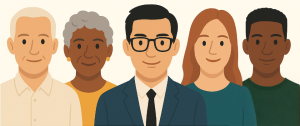Mental health has become a priority in discussions about workplace well-being, but how employees understand and approach the topic can differ significantly. Across generations, the way employees view, talk about, and seek support for mental health varies widely, shaped by upbringing, social norms, access to resources, and personal experiences.
Understanding these differences isn’t just helpful, it’s essential in multigenerational workplaces. It informs how organizations provide support, design benefits, and train managers to lead with empathy and awareness.
The Silent Generation and Baby Boomers: Privacy, Resilience, and Stigma
Baby Boomers (born between 1946 and 1964) and the tail end of the Silent Generation (born between 1928 and 1945), mental health has often been viewed through a more traditional or private lens. Many in this group were raised in a time when emotional struggles were expected to be handled quietly or internally. Seeking therapy may have once been viewed as a last resort or even a sign of weakness.
In the workplace, this can translate into hesitancy to disclose mental health issues or access available supports—even when those resources exist. These employees may value discretion, boundaries, and self-reliance, and they may not use language like “burnout” or “psychological safety,” even if they’re feeling the effects.
Generation X: Balancing Self-Reliance and Cautious Openness
Gen Xers (born between 1965 and 1980) tend to fall somewhere in between. While many were raised in environments that discouraged vulnerability, this generation also came of age during early public conversations about stress, work-life balance, and therapy. In the workplace, Gen X often values privacy but is open to discreetly using Employee Assistance Programs (EAPs) or seeking help.
They may also be less vocal about their needs than younger peers, preferring practical support over visible mental health campaigns. For employers, this highlights the importance of offering accessible, no-pressure resources that respect boundaries while encouraging engagement.
Millennials: Breaking the Silence
Millennials (born between 1981 and 1996) helped normalize conversations about mental health at work. Having grown up during a shift in public attitudes and an expansion of digital mental health resources, this generation tends to view mental health care as part of overall well-being, not separate from it.
In the workplace, Millennials are more likely to talk openly about burnout, stress, and the need for flexibility. They may expect mental health to be reflected in company culture, leadership training, and benefits—not just policy documents. Transparency, inclusivity, and access to care are often key expectations.
Gen Z: Mental Health as a Priority
Gen Z (born between 1997 and 2012) is now entering and reshaping the workforce. They are the most vocal and informed generation yet when it comes to mental health. They are more likely to talk about anxiety, depression, and trauma without stigma, and they often expect employers to support employee well-being in tangible, visible ways.
This group is highly attuned to language, representation, and psychological safety. They are also more likely to challenge norms around work intensity, hustle culture, and inaccessible leadership. For Gen Z, workplace mental health isn’t a bonus; it’s a baseline expectation.
What Employers Should Consider
Supporting a multigenerational workforce means recognizing that no single approach fits everyone. Here are a few considerations for bridging generational gaps in mental health perception:
- Offer flexible support options. Some may prefer in-person counselling, others a mental health app, and some may simply want workload adjustments. Variety matters.
- Train managers to lead with empathy. Leaders need tools to recognize generational differences in how mental health concerns are expressed—or hidden.
- Normalize conversation, but respect privacy. Visible support helps reduce stigma, but it should never come with pressure to share or disclose.
- Listen across age groups. Use anonymous surveys or feedback tools to understand what each group values when it comes to mental health resources.
Final Thoughts
Mental health expectations are evolving, and generational differences shape how employees experience support, stress, and stigma at work. A workplace that honours these differences while promoting a common standard of care and compassion is better positioned to support all employees, no matter their age or background.
By staying flexible, listening carefully, and leading with awareness, organizations can build a more inclusive and mentally healthy future of work.
Need help supporting mental health across age groups in your workplace? Ask us about custom training, manager coaching, and flexible program design rooted in legal compliance and best practice.
Resources for Workplace Mental Health
The Canadian Centre for Occupational Health and Safety (CCOHS) provides Healthy Minds@Work, a hub with tools and resources for supporting psychological health and safety in the workplace.
Provincial Workers’ Compensation Boards, including WSIB Ontario offer resources for workplace wellness initiatives.
Workplace Strategies for Mental Health, Canada Life, offers free articles and resources.











